

Books of All Types. Articles (Magazine, Newspaper, Scholarly Journal...) Summary: MLA (Modern Language Association) style is most commonly used to write papers and cite sources within the liberal arts and humanities.
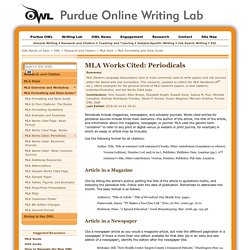
Websites. Summary: MLA (Modern Language Association) style is most commonly used to write papers and cite sources within the liberal arts and humanities.

This resource, updated to reflect the MLA Handbook (8th ed.), offers examples for the general format of MLA research papers, in-text citations, endnotes/footnotes, and the Works Cited page. Contributors: Tony Russell, Allen Brizee, Elizabeth Angeli, Russell Keck, Joshua M. Paiz, Michelle Campbell, Rodrigo Rodríguez-Fuentes, Daniel P. Kenzie, Susan Wegener, Maryam Ghafoor, Purdue OWL StaffLast Edited: 2018-04-03 02:30:44 It is always a good idea to maintain personal copies of electronic information, when possible.
MLA uses the phrase, “Accessed” to denote which date you accessed the web page when available or necessary. Important Note on the Use of URLs in MLA Include a URL or web address to help readers locate your sources. Many scholarly journal articles found in databases include a DOI (digital object identifier). Film & Video. A Tweet. Formatting Works Cited Page. Summary: MLA (Modern Language Association) style is most commonly used to write papers and cite sources within the liberal arts and humanities.
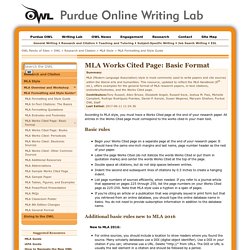
Purdue OWL: MLA Formatting: List of Works Cited.
Formatting an MLA Paper. MLA In-Text Citation Guide. Summary: MLA (Modern Language Association) style is most commonly used to write papers and cite sources within the liberal arts and humanities.
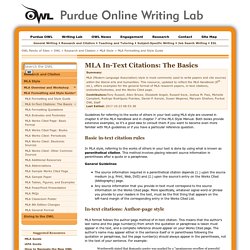
This resource, updated to reflect the MLA Handbook (8th ed.), offers examples for the general format of MLA research papers, in-text citations, endnotes/footnotes, and the Works Cited page. Contributors:Tony Russell, Allen Brizee, Elizabeth Angeli, Russell Keck, Joshua M. Paiz, Michelle Campbell, Rodrigo Rodríguez-Fuentes, Daniel P. Kenzie, Susan Wegener, Maryam Ghafoor, Purdue OWL StaffLast Edited: 2017-10-23 08:53:38 Guidelines for referring to the works of others in your text using MLA style are covered in chapter 6 of the MLA Handbook and in chapter 7 of the MLA Style Manual. Basic in-text citation rules In MLA style, referring to the works of others in your text is done by using what is known as parenthetical citation. General Guidelines The source information required in a parenthetical citation depends (1.) upon the source medium (e.g. MLA Paper: Doing the research & staying organized. How to Format a Paper in MLA 8: A Visual Guide.
MLA Formatting and Style Guide. Coming Soon: A new look for our same great content!
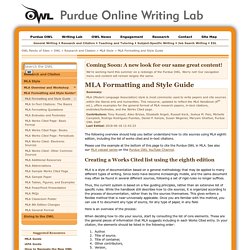
We're working hard this summer on a redesign of the Purdue OWL. Worry not! Our navigation menu and content will remain largely the same. MLA Sample Paper. Direct Quote - MLA Style Guide: 8th Edition - LibGuides at Western Oregon University. Quoted material should be reproduced word-for-word and exactly as it appears in the original source.
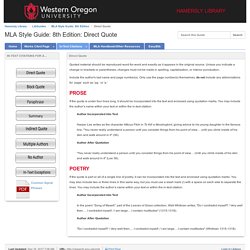
Unless you indicate a change in brackets or parentheses, changes must not be made in spelling, capitalization, or interior punctuation. Include the author's last name and page number(s). Only use the page number(s) themselves; do not include any abbreviations for ‘page’ such as ‘pg.’ or ‘p.’ Prose If the quote is under four lines long, it should be incorporated into the text and enclosed using quotation marks. Author Incorporated into Text Harper Lee writes as the character Atticus Fitch in To Kill a Mockingbird, giving advice to his young daughter in the famous line, "You never really understand a person until you consider things from his point of view… until you climb inside of his skin and walk around in it" (36). Author After Quotation "You never really understand a person until you consider things from his point of view… Until you climb inside of his skin and walk around in it" (Lee 36).
Block Quote (for long quotes) - MLA Style Guide: 8th Edition - LibGuides at Western Oregon University. The block quote is used for direct quotations that are longer than four lines of prose, or longer than three lines of poetry.
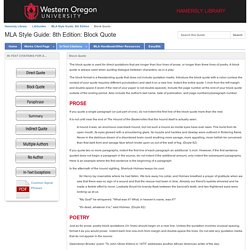
A block quote is always used when quoting dialogue between characters, as in a play. The block format is a freestanding quote that does not include quotation marks. Introduce the block quote with a colon (unless the context of your quote requires different punctuation) and start it on a new line. Indent the entire quote 1-inch from the left margin and double-space it (even if the rest of your paper is not double-spaced). Include the page number at the end of your block quote outside of the ending period. Prose If you quote a single paragraph (or just part of one), do not indent the first line of the block quote more than the rest: It is not until near the end of The Hound of the Baskervilles that the hound itself is actually seen: A hound it was, an enormous coal-black hound, but not such a hound as mortal eyes have ever seen.
"My God! " Poetry.